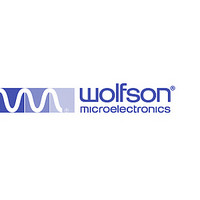WM8350GEB/V Wolfson Microelectronics, WM8350GEB/V Datasheet - Page 47

WM8350GEB/V
Manufacturer Part Number
WM8350GEB/V
Description
Audio CODECs Audio CODEC plus pwr management
Manufacturer
Wolfson Microelectronics
Datasheet
1.WM8350GEBV.pdf
(339 pages)
Specifications of WM8350GEB/V
Lead Free Status / RoHS Status
Lead free / RoHS Compliant
- Current page: 47 of 339
- Download datasheet (3Mb)
Production Data
12.3 CLOCKING AND SAMPLE RATES
w
The oscillator is enabled by the OSC32K_ENA field, as described in Table 7. It is enabled by default
and remains enabled when the WM8350 is in the OFF or BACKUP state.
R12 (0Ch)
Power
Mgmt (5)
R218 (DAh)
RTC Tick
Control
Note: OSC32K_ENA can be accessed through R12 or through R218. Reading from or writing to
either register location has the same effect.
Table 7 Enabling the 32kHz Oscillator
If a suitable 32.768kHz clock is already present elsewhere in the system, then it is possible for the
WM8350 to use this clock instead. An external clock can be provided to the WM8350 on pin X1 (with
pin X2 left floating) or else on a GPIO pin configured as a 32kHz input (see Section 20).
In addition to driving the RTC, the 32kHz oscillator signal can be output to a GPIO pin configured as
a 32kHz output; this is possible on GPIO pins 2, 3, 5 and 12 (see Section 20.2).
Clocks for the ADCs, DACs, DSP core functions, and the digital audio interface are all derived from a
common internal clock source, SYSCLK.
SYSCLK can either be derived directly from MCLK (with a selectable divide by two option, controlled
by MCLK_DIV), or may be generated by the FLL using MCLK or alternate sources as an external
reference. The SYSCLK source is selected by MCLK_SEL. Many commonly-used audio sample
rates can be derived directly from typical MCLK frequencies.
The ADC and DAC sample rates are independently selectable, relative to SYSCLK, using
ADC_CLKDIV and DAC_CLKDIV. These fields must be set according to the required sampling
frequency and depending upon the selected clocking mode. Two clocking modes are provided as
follows. Normal mode allows selection of the commonly used sample rates from typical audio
system clocking frequencies (eg. 12.288MHz); USB mode allows many of these sample rates to be
generated from a 12MHz USB clock. Depending on the available clock sources, USB mode may be
used to save power by supporting 44.1kHz operation.
In Normal mode,
In USB mode,
The above equations determine the required values for ADC_CLKDIV and DAC_CLKDIV. The
clocking mode is selected via the AIF_LRCLKRATE field.
In master mode, BCLK is also derived from SYSCLK via a programmable division set by BCLK_DIV.
In the case where the ADCs and DACs are operating at different sample rates, BCLK must be set
according to whichever is the faster rate. In Master Mode, internal clock divide and phase control
mechanisms ensure that the BCLK, ADCLRCLK and DACLRCLK edges will occur in a predictable
and repeatable position relative to each other and to the data for a given combination of ADC/DAC
sample rates and BCLK settings. In Slave Mode, the host processor must ensure that BCLK,
ADCLRCLK and DACLRCLK are fully synchronised; if these inputs are not synchronised,
unpredictable pops and noise may result.
ADDRESS
ADC_SYSCLK = 256 x ADC Sampling Frequency
DAC_SYSCLK = 256 x DAC Sampling Frequency
ADC_SYSCLK = 272 x ADC Sampling Frequency
DAC_SYSCLK = 272 x DAC Sampling Frequency
BIT
10
12
OSC32K_ENA
LABEL
DEFAULT
1
32kHz crystal oscillator control
0 = 32kHz OSC is disabled
1 = 32kHz OSC is enabled
DESCRIPTION
PD, March 2010, Rev 4.2
WM8350
47
Related parts for WM8350GEB/V
Image
Part Number
Description
Manufacturer
Datasheet
Request
R

Part Number:
Description:
Wolfson Audioplus? Stereo Codec With Power Management
Manufacturer:
Wolfson Microelectronics plc
Datasheet:

Part Number:
Description:
Manufacturer:
Wolfson Microelectronics
Datasheet:










